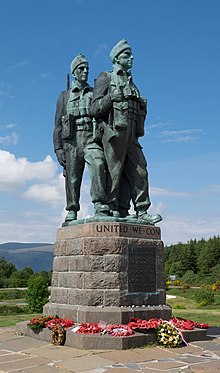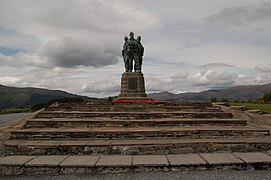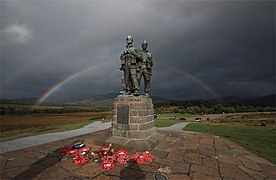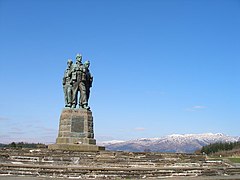Commando Memorial
 The memorial in June 2016 | |
 | |
| 56°53′52.42″N 4°56′38.51″W / 56.8978944°N 4.9440306°W | |
| Location | Lochaber, Scottish Highlands |
|---|---|
| Designer | Scott Sutherland |
| Type | statue |
| Material | bronze sculpture |
| Height | 17 feet (5.2 m) |
| Beginning date | 1949 |
| Completion date | 1951 |
| Opening date | 1952 |
| Dedicated to | British Commandos |
The Commando Memorial is a Category A listed monument in Lochaber, Scotland, dedicated to the men of the original British Commando Forces raised during World War II. Situated around a mile from Spean Bridge, it overlooks the training areas of the Commando Training Depot established in 1942 at Achnacarry Castle. Unveiled in 1952 by the Queen Mother, it is one of Scotland’s best-known monuments, both as a war memorial and as a tourist attraction offering views of Ben Nevis and Aonach Mòr.
History
In 1949, the sculptor Scott Sutherland won a competition open to all Scottish sculptors for the commission, The Commando Memorial.[1] Sutherland's design won first prize of £200.[2] The base of the bronze statue is inscribed with the date of 1951. The sculpture was cast in the H.H Martyn and Company's foundry.[3] The memorial was officially unveiled by the Queen Mother on 27 September 1952.[3][4][5] The monument was first designated as a listed structure on 5 October 1971, and was upgraded to a Category A listing on 15 August 1996.[6] On 18 November 1993 a further plaque was added to mark the Freedom of Lochaber being given to the Commando Association.[7] On 27 March 2010 a 2 miles (3.2 km) war memorial path was opened connecting two local war memorials, the Commando Memorial, and the former High Bridge built by General Wade, where the first shots were fired in the Jacobite Rising of 1745 in the Highbridge Skirmish.[8]
Description
The monument consists of a cast bronze sculpture of three Commandos in characteristic dress complete with cap comforter, webbing and rifle, standing atop a stone plinth.[3] The soldier at the front is thought to depict Commando Jack Lewington who frequently attended Remembrance Services at the monument during his lifetime. One of the other two soldiers is Frank Nicholls (rank unknown) the other is regimental sergeant major Sidney Hewlett. Originally from the Welsh guards but hand picked to be one of the founding Ncos of the commandos he was also held in high regard and noted several times by Eisenhower upon three Commandos are depicted looking south towards Ben Nevis.[9] The entire monument is 17 feet (5.2 m) tall.[7][10] The monument has been variously described as a huge, striking and iconic statue.[9][10][11]
"United we conquer" is inscribed around the top of the stone plinth, while the original plaque on the stone plinth reads: "In memory of the officers and men of the commandos who died in the Second World War 1939–1945. This country was their training ground."[3][4]
Location
Spean Bridge is a small village around 8 miles (13 km) north-east of the town of Fort William in the Scottish Highlands, and the memorial is located approximately 1 mile (1.6 km) north-west of Spean Bridge, at the junction of the A82 road and the B8004 road. It is a prominent landmark visible from the A82, and the site itself offers views across the River Spean valley to the peaks of Ben Nevis and Aonach Mòr to the south.[9][12]
The location was chosen because it is on the route from Spean Bridge railway station to the former Commando Training Centre at nearby Achnacarry Castle. Arriving prospective Commandos would disembark after a 14-hour journey, load their kit bags onto waiting trucks and then speed march the 7 miles (11 km) to the training centre in full kit with weapon, weighing a total of 36 pounds (16 kg). Anyone not completing it within 60 minutes was immediately RTU'd (returned to unit).[1][13]
It has become one of Scotland's best-known war memorials and a popular tourist attraction, visited by tens of thousands of people every year.[12]
Memorial


The monument stands as a memorial to the British Commandos who trained all around the Lochaber region which the monument overlooks, while they were based at the Achnacarry Commando Training Centre established in 1942.[10][11][14] As such it is used as site for memorial services, including the 60th anniversary of D-Day, and Remembrance Day ceremonies.[9][15]
A Garden of Remembrance, which was subsequently added to the site, is used by many surviving World War II Commandos as the designated final resting place for their ashes.[10][12] It has also been used as a place where many families have scattered ashes and erected tributes to loved ones who belonged to contemporary Commando units and who have died in more recent conflicts such as the Falklands War or in Afghanistan and Iraq.
Sculptor
Scott Sutherland (15 May 1910 - 10 October 1984) was an award-winning Scottish sculptor born in Wick, Highland and schooled at Gray's School of Art, the Edinburgh College of Art and the École des Beaux-Arts in Paris. After touring Europe and winning two out of the five open commissions offered for the Empire Exhibition, he served in the Army during World War II, working alongside commandos. After the war he took the post of Head of Sculpture at Duncan of Jordanstone' College in 1947. Sutherland was elected ARSA (Associate of the Royal Scottish Academy) in 1950 and FRBS (Fellow of the Royal British Society of Sculptors) in 1961. In 1975 he retired, and died nine years later in hospital in Dundee.[1]
Gallery
- For a full gallery see The Commando Memorial page on the Wikimedia Commons
See also
- List of Category A listed buildings in Highland
- List of post-war Category A listed buildings in Scotland
- Scottish war memorials
References
- ^ a b c "Sutherland, Scott". Biographies of British Artists. London Atelier of Representational Art. 13 December 2008. Archived from the original on 7 April 2010. Retrieved 6 April 2010.
- ^ "Commando Memorial". Commando Magazine. 23 April 2008. Archived from the original on 7 April 2010. Retrieved 6 April 2010.
- ^ a b c d "Commando Memorial". Memorials database, result for entry 5894. UK National Inventory of War Memorials. n.d. Archived from the original on 7 April 2010. Retrieved 6 April 2010.
- ^ a b "Commando war memorial". War Memorials Trust. n.d. Archived from the original on 17 July 2011. Retrieved 6 April 2010.
- ^ "Memorial to Commandos - Unveiling by The Queen Mother". The Times. 29 September 1952. Retrieved 29 August 2012.
{{cite news}}: Check|archiveurl=value (help) - ^ Historic Environment Scotland. "Spean Bridge, Commando Memorial (Category A Listed Building) (LB6842)". Retrieved 22 March 2019.
- ^ a b "Commando Monument". Gazetteer for Scotland. 29 January 2008. Archived from the original on 7 April 2010. Retrieved 6 April 2010.
- ^ "Lochaber landmarks footpath opened". The Press and Journal. D. C. Thomson & Co. 27 March 2010. Archived from the original on 7 April 2010. Retrieved 6 April 2010.
- ^ a b c d "Prayers in shadow of Ben Nevis". BBC News. 1 May 2004. Archived from the original on 7 April 2010. Retrieved 6 April 2010.
- ^ a b c d "Sick thieves pinch memorial stones from Commando statue". Daily Record. 2 December 2008. Archived from the original on 7 April 2010. Retrieved 6 April 2010.
- ^ a b "Wars' mark on Highlands landscape". BBC News. 13 June 2008. Archived from the original on 7 April 2010. Retrieved 6 April 2010.
- ^ a b c "Memorial 'an insult to heroes who died for their country'". Daily Mail. 12 June 1999. Retrieved 6 April 2010.
- ^ WO2 Gareth Evans MBE RM (n.d.). "The Spean Bridge Commando Speed March". royalnavy.mod.uk > Operations and Support > Royal Marines (Old) > Royal Marines Units > Commando Training Centre > News. Royal Navy. Archived from the original on 7 April 2010. Retrieved 6 April 2010.
{{cite web}}: CS1 maint: numeric names: authors list (link) - ^ "Thieves take commando donations". BBC News. 6 November 2008. Archived from the original on 7 April 2010. Retrieved 6 April 2010.
- ^ "City set to celebrate VE Day in style". Evening Telegraph And Post. D. C. Thomson & Co. 5 May 2005. Archived from the original on 7 April 2010. Retrieved 6 April 2010.
External links
- In pictures: Commando gathering, 29 April 2004








